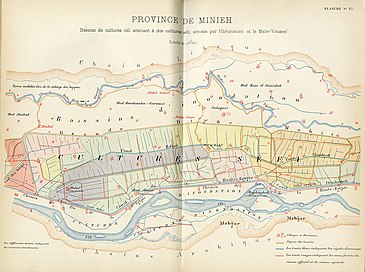Daira Saniyya light railways
| Daira Saniyya light railways including the al-Minya (Minieh) field railroad |
|||||||||||||||||||||
|---|---|---|---|---|---|---|---|---|---|---|---|---|---|---|---|---|---|---|---|---|---|
|
Light railway at the Nag Hammadi sugar factory built by Fives-Lille in 1895–1897 (300 km south of al-Minya)
| |||||||||||||||||||||
|
Al-Minya light railway and Upper Egyptian railway (red lines) and
irrigation canals (blue lines) in the province of al-Minya (Minieh), 1891. North is on the right, i.e. H. Cairo is on the right and Luxor on the left of the section. | |||||||||||||||||||||
| Route length: | 250-470 km | ||||||||||||||||||||
|
|||||||||||||||||||||
The Daira Saniyya light railways were more than 250 km long narrow-gauge railway network in Egypt on the 340,000 hectares of the Khedive Ismail Pasha managed by the Daira Saniyya , including the light railway of the al-Minya province , 250 km south of Cairo on the western bank of the Nile .
history
To transport the building materials for the sugar factories and to transport the sugar cane and sugar products, the Khedive Ismail Pascha had the French companies Cail and Fives-Lille built around 14 sugar factories in 1867–1875 , which provide the basis and the technical infrastructure for the modern cane sugar industry Middle and Upper Egypt formed. British firms built further sugar factories. The turnkey construction projects, including the machines, were each erected by a European general contractor from prefabricated iron truss structures according to a concept that was later applied in other regions of the world.
Around 1878 the administration of the Khedive estates, called Daira Saniyya , operated around 15 sugar factories, 250 kilometers of railway lines, 50 locomotives and 1,500 wagons. The Egyptian sugar factories could produce 100,000 tons of raw sugar per year and each had a still to distill alcohol. The sugar factories were able to process up to 1,500 t of sugar cane per day at each location, which was transported from the fields to the factories within a few hours by field train after the harvest.
By 1900 there were still nine sugar factories managed by Daira Saniyya , producing raw sugar for the refinery abroad, molasses for the local market and alcohol. In a deal drafted by the Egyptian Consul General Lord Cromer due to the high international debt, the Daira Saniyya's sugar factories and light railways, but not the property of the plantations, were sold to Société Générale de Sucreries , which had previously operated two comparatively modern sugar factories in the area. This got into financial difficulties in 1905 after the suicide of its managing director Ernest Cronier, whereupon it sold the railway network to the state. The sale of 470 km of railroad tracks, 65 locomotives and 2092 wagons to the Egyptian state in 1905 brought the Société Générale de Sucreries a proceeds of E £ 400,000 .
Individual evidence
- ↑ Alfred J. chelu: De l'équateur à la Méditerranée le Nil, le Soudan, l'Egypte. Chaix, Paris, 1891, plate 57.
- ↑ a b Ralph Bodenstein: Sugar and Iron: Khedive Ismail's sugar factories in Egypt and the role of French engineering companies (1867-1875).
- ↑ Adam Mestyan: A garden with mellow fruits of refinement. P. 56: Al-Dāʾira al-Saniyya (the administration of the state domains) and al-Dāʾira al-Khāṣṣa or Dāʾira-ı Khāṣṣa (Ismāʿīl's private administration) were not clearly separated.
- ↑ Roger Owen: The Study of Middle Eastern Industrial History: Notes on the Interrelationship between Factories and Small-Scale Manufacturing with Special References to Lebanese Silk and Egyptian Sugar, 1900-1930. In: International Journal of Middle East Studies. Volume 16, No. 4, November 1984, pp. 479-481. Cambridge University Press.
- ^ A b Uri M. Kupferschmidt: Henri Naus Bey: Retrieving the Biography of a Belgian Industrialist in Egypt. Pp. 44-46.
Coordinates: 28 ° 38 '44.1 " N , 30 ° 51' 0.9" E

